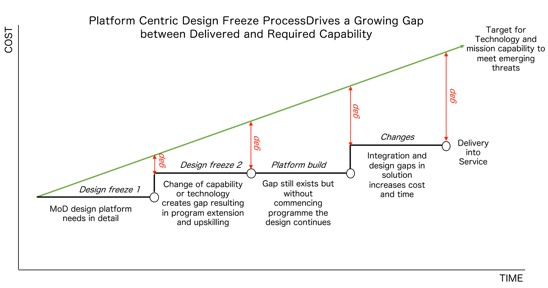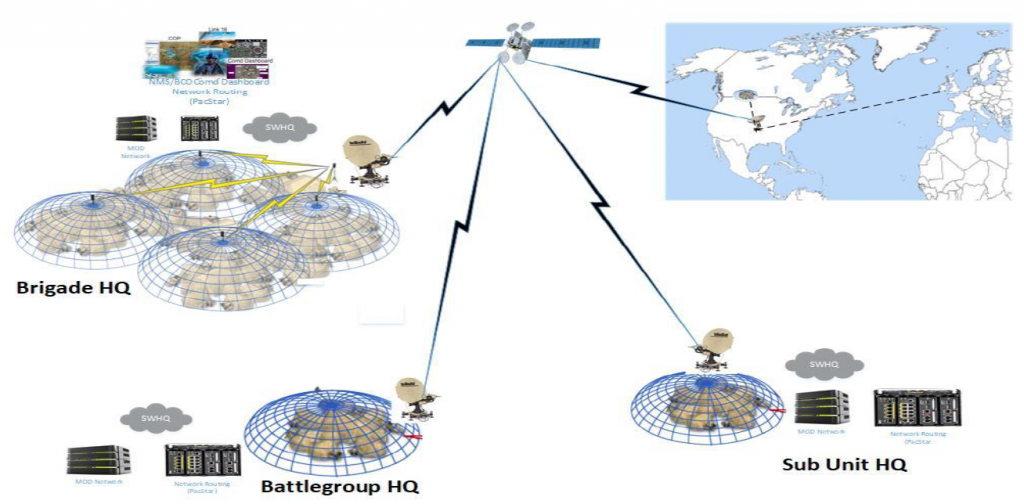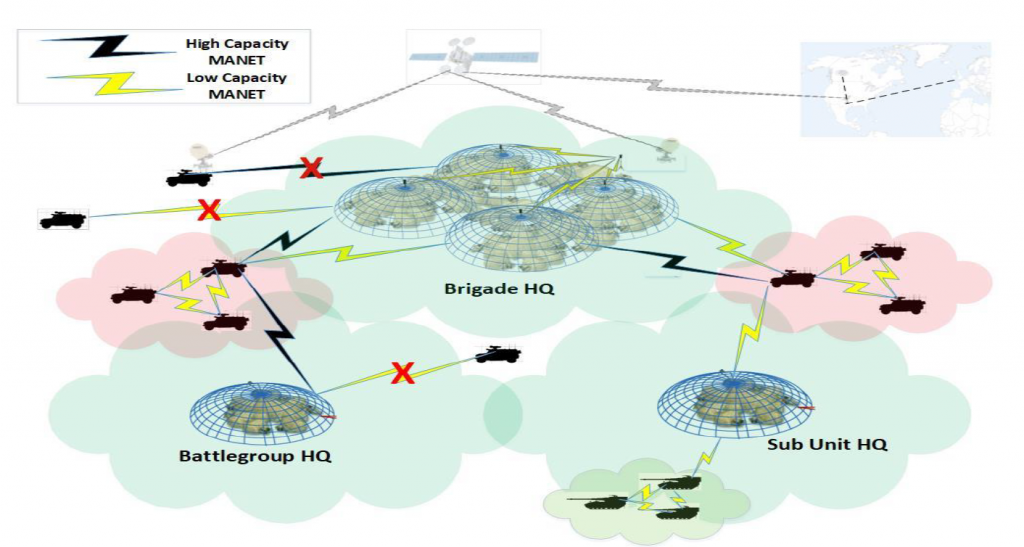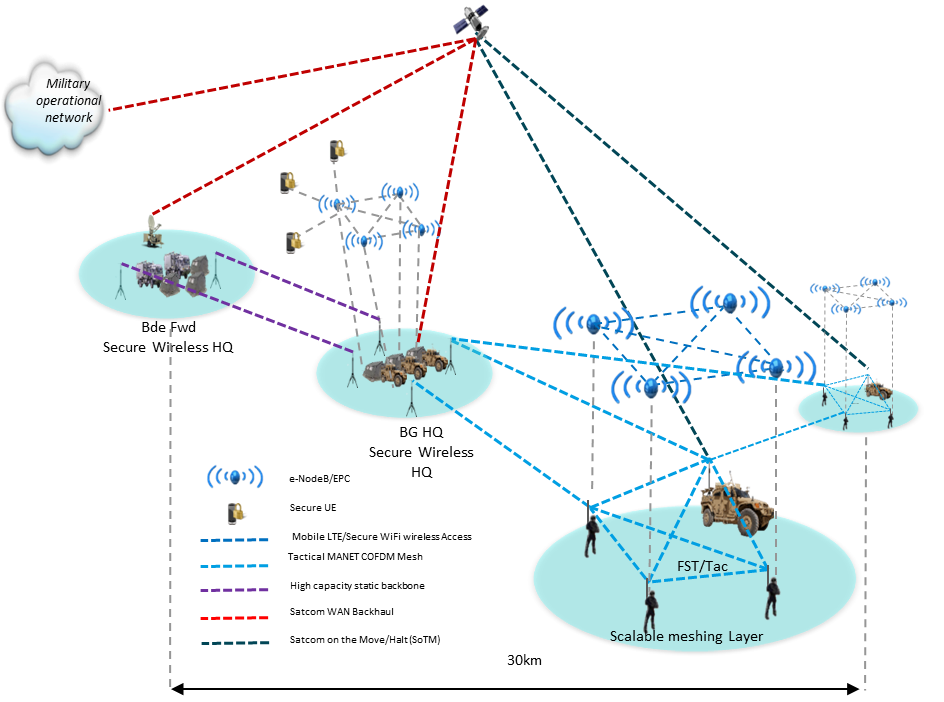Creating and or maintaining superiority in all military domains is even for superpowers hard to achieve and most cases unaffordable. However, the one who is capable of stacking up the capabilities of all the domains in a coordinated way and moves fastest through the OODA loop beats their opponent by acting first and changing the situation for an adversary.
Communication, interoperability and extract timely actionable information from haystack of data are key for effective multidomain operations.
Due to technological developments and the fact that more and more sensors are being added to the ‘tactical edge’, data usage in a multi-domain and coalition environment continues to grow exponentially. This has major consequences for networks, radios, bandwidth, frequencies and interoperability of communication and information systems. The consequences of this development are not completely realized at all levels.
Our drive is to make our customers more effective and our focus is on the end users, sharing experiences, as well as informing them about the latest state of technology in the field of C5ISR, robotics and sensors. With the motto: doing and experiencing together provides insight into the possibilities and limitations of existing and new technology; this increases awareness, creates imagination and provides direction for the future and potential next steps to be taken.
In general, acquisition projects for innovative technical equipment at defense organizations worldwide are challenging. Often long lead times, budget over spending, postponement, skeptical end users and the equipment is often outdated when commissioned.
To create better customer outcomes BSS, with other partners under initiative of Viasat are working closely together with industry experts on proposals to increase procurement agility, reduced risk and to deliver mission capabilities early and cheaper.
In another white paper we will explain more and further elaborate on our proposals to increased procurement agility to deliver mission capability early and cheaper.

There are technologies, (market/industry) standards and suppliers that can considerably simplify interoperability in the network and C2 applications which can reduce investment in middleware and system integration.
The concepts, solutions, products and vendors mentioned in this paper are examples and not an exhaustive list. With some of the vendors BSS has a commercial relation and to orchestrate solutions that fits the end users’ requirements we are open to cooperate with others.
Key elements of this paper are the following:

The need to remain fully connected during high tempo maneuver tactical operations, and the ability to ‘reach back’ to deployed higher HQs, or into the strategic cloud will be key to enabling future operational effect.
A future network must be capable of delivering stable, resilient and high capacity bandwidth to any part of the battlefield as the ‘tactical edge’ becomes increasingly blurred. It must also be capable of connecting current and future multi-domain tactical information systems via a flexible and dependable transport network. Critically, it must be capable of connecting those deployed tactical units and systems to the deployed and dispersed HQ formations that are supporting and commanding them.
In order to achieve this fully integrated heterogeneous connected environment we must focus on the integration of three common and currently understood network capabilities in order to develop a fused network approach:
Upper Tactical Internet (Upper TI)
This is the network that provides the high capacity deployed internet connectivity for all other sub systems and networks. It should be envisaged as a high capacity Wide Area Network that enables deployed formations and users to access strategic or in-theatre voice and data services and interoperable systems. It is bearer agnostic, provides dispersed connectivity and has an active network management and cybersecurity capability.
Lower Tactical Internet (Lower TI)
This is the network that supports a multitude of tactical systems, usually low throughput and highly mobile. These sub-systems use the Upper TI as a transport network to remain connected to other Lower TI systems and networks across the battlespace.
Dispersed and Secure Wireless HQ (SWHQ)
This is the deployed C3 domain which supports deployed units in both centralized and decentralized command and control states. It is capable of connecting and enabling multi-domain systems, for both OpCIS and TacCIS, and is highly agile. This system is designed to support dispersed HQ or CP functions to increase maneuverability and survivability.
In a contested, congested, and varying terrain environment, continuous and assured network access is critical to leverage investments in battlefield sensors, real-time Intelligence, Surveillance, and Reconnaissance (ISR) in order to maintain information dominance against our adversaries. Currently, maintaining that level of resilient network requires much manual setup and human intervention and typically delivers suboptimal performance based on the network operator or users’ level of knowledge and understanding of the holistic network environment. Communications can be impacted by topography, weather, radio frequency (RF) interference (noisy environment), cyber-attack or adversary EW attack, and human driven network management can be suboptimal for routing around network deficiencies and inefficiencies.
A brigade will substantially rely on robust communications to support Manned Un-Manned Teaming (MUM-T), Command and Control (C2), sensing including sensor data collection, Position Location Information (PLI), fires/Cursor-on-Target (CoT), real-time video, image recognition, bio-monitoring and other various ISR data needs for Line of Sight (LOS) and Beyond LOS (BLOS) engagements. The ‘end-to end’ networks of networks could have one or more Tactical SATCOM (TACSAT), high-capacity SATCOM, tactical radio, high-density and high-capacity Mobile Ad-Hoc Networking (MANET), or Direct Line of Sight (DLOS) connections available depending upon its mission and environment.
Our ARHAN solution enables Service based integration with an end-to-end managed, optimized, and resilient network centered on Automated Multi-bearer resilience with SDN Bonding/Routing; Network Management, Monitoring, and Visualization; Converged Compute, and Tactical Radio Gateway platforms. This will provide a rapidly deployable integrated communication platform for commanders to be able to sense, shoot, move, and communicate anytime and anywhere during operations. The following sections provide an overview of the each of the components of our ARHAN solution.
Overview Beyond line of sight SATCOM – Hybrid Adaptive Network (HAN)
The vision for HAN is that it “will provide an operationally effective, affordable, resilient, and secure satellite communications architecture that supports global mission priorities and is adaptable to rapidly changing requirements, technologies, and threats.”
HAN is to provide satellite communications capabilities “in order to support joint warfighters across the full spectrum of conflict, in CDO [contested, degraded and operationally-limited environments] and tactically-relevant timelines”.
SATCOM suppliers can currently offer simultaneous connectivity on multiple networks, and these networks span different frequency bands, orbits and waveforms – demonstrating that the HAN can serve as the foundation for all-domain operations providing warfighters with a scheme of maneuver, enhanced situational awareness and significantly improved resilience that will help warfighters maintain a tactical advantage across the battlespace. The ability to roam across layers of networks is not only a deterrent but a fundamental enabler for decisive operations in CDO environments.
CDO environments look to be a priority for military customers, as the vision says that we “must move faster than our adversaries to ensure warfighters receive the operational benefits of a SATCOM enterprise capable of delivering SATCOM effects in CDO environments.”
Commercial satellite companies are to be a key piece of the goal to improve network agility.
New constellation will be a game-changer for DoD and our allies. Military operations are planned based on limited capacity and potential interference but imagine an operational environment in which warfighters are not bandwidth constrained. The new constellations will provide global coverage and advanced resilience features able to deliver more than 3TB [three terabits per second] of capacity to users anywhere in the world. So all users will be able to double or triple their operational use cases and even the users lowest on the priority list will still be provided assured communications when and where they need it.
A HAN multi-network approach and a service-based model of service could permit a significant DoD enhancement of “a range of capabilities providing the warfighter with affordable, resilient options on demand”. These hybrid managed service architectures offer insight to military leaders looking to transition to a managed service-based model and validate the enhanced performance, resilience, affordability and security advantages of SATCOM-as-a-Service business models that have been and are continuously evolving and improving to incorporate new, higher performance satellite networks as they become available and to better match the customer (user) demand for higher performance and affordability.”
A network of layers is a force multiplier that increases SATCOM resilience and deterrence. By being able to roam across multiple networks (government and commercial) and orbital regimes, warfighters will be able to leverage specific capabilities or advantages needed to successfully execute their mission. LEOs may provide some advantages in specific operations while GEOs may provide better capabilities in others, but the ability for warfighters to easily roam among networks and orbital regimes in a single SATCOM enterprise will be key to enhancing mission effectiveness and maintaining superiority in space.
Multi Mission Terminal (MMT)
This multiband capable SATCOM terminal delivers IP-based network services over X-, Ku-, commercial Ka-, and military Ka-bands, and is ready for operation with high-capacity satellite service enabling secure and resilient communications, in both benign and contested environments.
Deployment
The SWaP makes the MMT the ideal solution to provide a network backbone and reach back capability for a light/agile Brigade deployment. It enables the capability to be deployed to the edge of the battlefield. Multiple MMTs in the network architecture will allow for redundancy and resilience for mission critical network connectivity and data flow.
Connectivity
With the MMT deployed at Bde, BG and Sub-Unit level and in conjunction with redundant and resilient Satcom ground stations, the network remains extant in almost any situation, thus providing the necessary and critical data paths for reliable and robust communications.
The MMT is able to provide bandwidth in excess of 100Mbps (Down) and 20Mbps (Up). Use cases have shown that even with the high latency attributed to Satcom links, it is able to deliver time critical services (Voice/Video/Data) efficiently and effectively.
Multi-Mission Terminal

Provision of inter-nodal network connectivity at relatively high bandwidth can be provided using High Capacity Line of Sight (HCLOS) and HC Mobile Ad-Hoc Networks (MANET). Combining the 2 technologies enables a ‘plug n play’ configuration capable of delivering high capacity and resiliency to the network.
Deployment – Connections, Resilience & Redundancy
This diagram shows configuration using HCLOS/MANET to transport data around the network. In the represented configuration it assumes that path profile allows for LOS between the various locations.
Tethered drones, directional antennas and radio rebroadcast will be used to maximize range and mobility options to maintain high data capacity to the tactical edge.
Brigade HC LOS network, inter-connected with single link failure resilience
HCLOS suppliers;
MANET suppliers;
Tethered drone (vertical height antenna) supplier;
High Capacity Line of Sight (HCLOS) is a small form factor, highly maneuverable, mil standard, best of breed Point-to-Point radio system. With low SWaP-C, high spectral efficiency, anti-jam dynamic spectral optimization (DSO) and certified link security, the HCLOS provides outstanding range (up to 25km for network planning) and high capacity (up to 450Mbps) options for securely interconnecting Bde to BG HQs.
The HC Mobile Ad-Hoc Networks (MANET) is a best of class small form factor, self-forming/self-healing ruggedized MANET radio system. The HC MANET provides high data throughput (up to 100Mbps over 5km (for network planning) and superior on-vehicle mobility performance.
The proposed HCLOS/HC MANET ’plug and play’ configuration presents and agile, low SWaP solution with significant training and management overhead benefits.
A Free Space Optical Communication link is shown within the Figure 3 configuration. The solution is in development and, if available, could be demonstrated as a proof of concept between Bde HQ and a BG HQ.
Free Space Optical Communication (FSOC) is a non-electro-magnetic line of sight technology, to wirelessly transmit video, voice and data at high speeds of up to 20 Gbps. A single link can cover distances up to 20 km. The effective range may be increased by relaying links. Solutions can be used to provide fiber backhaul, rapidly extend the existing architecture, and create local area networks. FSOC does not require right of way permits or spectrum licenses. Data is transmitted using eye safe lasers in the unregulated infra-red band (193 THz).
The FSOC link can be link assured with for example KG 142 high capacity encryptor.
Software defined radios operate using the robust TSM (TSM-6) waveform, and at the core of the waveform is Barrage Relay™ patented technology that provides continuous and flexible frequency coverage and transparent IP networking adaptable to harsh RF environments. The low Size, Weight, and Power (SWaP) radios support scalable on-the-move communications without having to manually change out RF bands and modules, or antennas.
The TSM-6 waveform provides simultaneous voice, data, video, and position location information (PLI) with enhanced network throughput, multi-cast HD video, flexible bandwidth, adaptability capability, and waveform portability for highly mobile operations.
Tactical radios with TSM waveform Below a number of TSM multichannel options produced by L3Harris, Collins Aerospace and Ultra that are suitable for mounting in vehicle;
Scalable Tactical MANET for Mounted and Dismounted voice and data services
For resilience, consideration should be given to a mobile Satcom feed to provide a reach back function for remote, disconnected assets. The current implementation and available bandwidth capacity of Satcom on the Move (STOM) capabilities presents a significant balance of investment consideration. Satcom at the halt (SATH) is seen as an optimal solution to maintain rich data services to the tactical edge and this concept evaluation can be proven with the on-vehicle and MMT solutions.
The recommended option would be to have all vehicles with Narrowband (NB) MANET capability with a primary vehicle having both HC and (NB) MANET. As vehicles transit as part of a convoy, the prime vehicle would automatically connect to the HC or NB MANET bubble when within range.

In order to provide enhanced capability in a DIL environment, we have developed a novel open architecture platform that supports Primary, Alternate, Contingency, and Emergency (PACE) management and goes beyond PACE by allowing for several network links to be aggregated together to provide a single, logical connection between nodes.
This approach allocates a single traffic session (e.g. TCP/UDP/Encrypted flow) across multiple links.
Packets are aggregated at the distant end and put back into correct order (ensuring high assurance VPN tunnels will operate correctly). Performance is measured continuously and the rate of data down each interface is adjusted in real-time based on network availability.
This technology would allow the Battlegroup (in our scenario) to aggregate multiple disparate communication paths that can be leveraged for enhanced throughput and resiliency and supports a wide variety of communication bearers including MANET, DLOS (RF and Free Space Optics) and SATCOM.
The SDN Bonding Router leverages substantial commercial investment in SDN technology, supporting industry-standard router features, such as OSPF/BGP, VPN support, DHCP/DNS/NTP.
Additionally, SDN technology has brought significant advancements in commercial network routers, including greater network visibility, planning and orchestration, in addition to features that have optimized the movement of data across networks including application-aware routing.
Providing client / server bonding solution that seamlessly interface to the typical transport protocols, such as TCP and UDP, providing PACE management and load-balancing through bonding of data across multiple communication paths with status and management across diverse communication bearers. This component of our solution will take these connections and transmit data across all available links on the client application.
The server application will aggregate these results back together and provide them to the intended destination. Additionally, the bonding solution can be used to monitor for and send certain types of data over specific communications links.
Our SDN Bonding router is a software application designed to run on a number of virtualized platforms and is being proposed to run on the MOJO Enterprise Gateway (MEG) platform for this effort.
The SDN Bonding Router will be managed through the same open-standard interfaces available in the IQ Core NCM.

A Dispersed and Secure Wireless Network capability is aimed at enabling the following:
The use of wireless technology has been considered in the military environment for many years but only now with the current adversary profiles that exist is the use of such technology being considered in the Operational and Tactical Domains. There are many reasons why the world’s military were reluctant to embrace wireless technology in the past, two examples are:
However, during recent conflicts for example in Iraq, Afghanistan and Syria it has become accepted that military operations are conducted whilst civilian commercial infrastructure continues to function. This is particularly the case when operating in Urban Environments.
So an increasing willingness to exploit common commercially available technologies such as 4G/LTE and WiFi in a HQ location is becoming more realistic. The use of such technologies however would have to be carefully managed in order to ensure the HQ’s RF profile is controlled and managed in a way that emissions are largely contained within the HQ boundary or it ‘blends’ with the local RF environment, minimizing operational risk and allowing the HQ to ‘hide in plain sight’.
Whilst developing the future Secure Wireless HQ System we have incorporated multiple layers of encryption and authentication to reduce the risk of the user data being transited across the wireless systems being compromised.
Steps to mitigate or reduce the effects of DDoS Attacks, system interference and jamming and enabling the HQ’s ability to impose layered EMCON measures are being incorporated in the SWHQ. This is achieved by providing access to multiple wireless technologies whilst managing them automatically, without user intervention using cognitive PACE (Prime, Alternate, Contingency, Emergency) Link Management. Using multiple cognitive PACE managed wireless bearer systems in the SWHQ allows them to be switched into and out of operation to suit the HQ’s EMCON needs and to control and dictate the HQ’s RF signature in a changing threat environment.
Finally, the integration of cutting-edge Battlefield Cyber Operations (BCO) capability in the form of embedded Network Security Monitoring (NSM) Systems increase the Cyber resilience of the deployed systems, working hand in hand with the PACE Management System to manage and control the flow of user data across the various wireless network interfaces.
The SWHQ system has been designed to be modular and can therefore scale up from small compact HQ deployments to larger distributed HQ formations. The wireless access technology selected for the solution has been chosen to deliver maximum coverage in a low threat, benign operational environment through to a zero RF signature tactical configuration in a high threat environment
